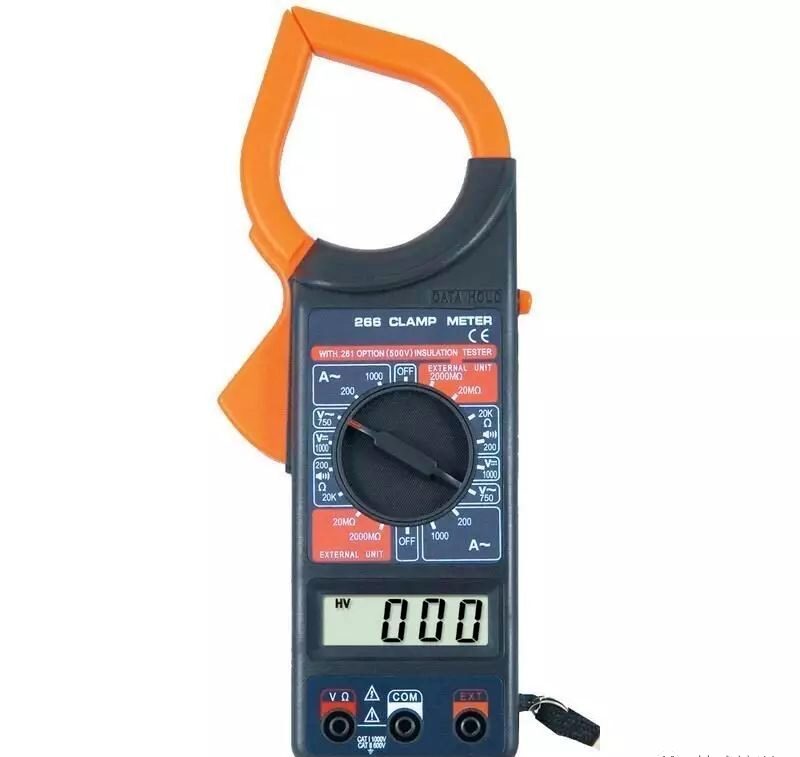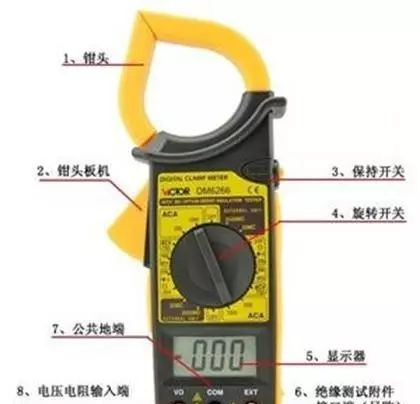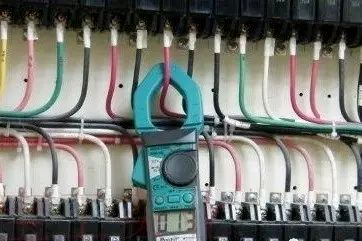A clamp multimeter is composed of a current transformer and a multimeter. The core of the current transformer can open when the clamp is squeezed; the wire carrying the current to be measured can pass through the opening of the core without being cut. When the clamp is released, the core closes.

A clamp multimeter is composed of a current transformer and a multimeter. The core of the current transformer can open when the clamp is squeezed; the wire carrying the current to be measured can pass through the opening of the core without being cut. When the clamp is released, the core closes.
When we need to measure current without breaking the circuit, we need to use a clamp multimeter (sometimes referred to as a clamp meter). A clamp multimeter is an instrument used to measure the current in an operating electrical line, and it is a common measurement tool for electricians. Clamp multimeters are divided into two main categories: clamp AC multimeters and clamp AC/DC multimeters, some of which can also measure AC voltage.
Structure:

The clamp AC multimeter is essentially composed of a current transformer and a rectifying meter. The wire carrying the current to be measured acts as the primary winding of the current transformer, while the secondary winding is on the core of the transformer, connected to the rectifying meter. Based on a certain proportional relationship between the primary and secondary windings of the current transformer, the rectifying meter can display the current value of the measured circuit.
The clamp AC/DC meter is an electromagnetic instrument, where the wire carrying the current being measured serves as the excitation coil. A magnetic circuit is formed in the core, and the electromagnetic measuring mechanism is located in the gap of the core, deflecting under the influence of the magnetic field to obtain readings. Since its deflection is not affected by the measured current, it can measure both AC and DC currents.
Usage Method:

Using a clamp multimeter is simple. As shown in the image, when measuring current, just clamp the wire being measured into the core of the clamp multimeter and then read the display screen or dial.
It’s very simple, isn’t it? Just clamp the wire to be measured. However, with the widespread use of digital clamp multimeters, many multimeter functions have been added, such as voltage, temperature, resistance, etc. (sometimes these multifunctional clamp meters are referred to as clamp multimeters, as shown in the image, with two probe sockets on the instrument). Different functions can be selected using a knob, and the usage method is similar to that of a general digital multimeter. For some specific function buttons, refer to the corresponding manual.

Phase Sequence Testing:
(1) Turn the dial to the phase sequence detection position;
(2) Insert the yellow, black, and red probes into the c, COMb, and VΩa sockets in order;
(3) Connect the red, black, and yellow probes to A, B, and C (or L1, L2, L3). When the red and black probes are connected, the indicator light glows dimly. When the yellow probe is connected, the indicator light turns on, indicating a positive phase sequence; if the indicator light goes out, it indicates a negative phase sequence;
(4) The phase sequence function can also measure inter-phase voltage.
AC Voltage Measurement:
(1) Turn the dial to the AC voltage position;
(2) Connect the red and black probes to the VΩa and COMb sockets;
(3) Connect the other ends of the red and black probes to the measurement points and read the value.
AC Current Measurement:
(1) Select the appropriate current range;
(2) Fully clamp the wire to be measured with the clamp and read the data;
Note: The maximum test current for this instrument is only 600A; do not test currents exceeding 600A.
DC Voltage Measurement:
(1) Select the appropriate DC voltage range;
(2) Connect the red and black probes to the VΩa and COMb sockets;
(3) Connect the other ends of the red and black probes to the measurement points and read the value.
Resistance Measurement:
(1) Turn the dial to the 2kΩ resistance range;
(2) Connect the red and black probes to the VΩa and COMb sockets;
(3) Connect the other ends of the red and black probes to the measurement points and read the value;
Note: Resistance can only be tested when the power is off.
Line Continuity Measurement:
(1) Turn the dial to the diode position;
(2) Connect the red and black probes to the VΩa and COMb sockets;
(3) Connect the other ends of the red and black probes to the measurement points and read the value. If the value is very small and the multimeter emits a “beep” sound, the circuit is closed; otherwise, if the value displays “1” and the multimeter does not beep, the circuit is open or has a very high resistance.
Note: Line continuity can only be tested when the power is off.
(1) Before using a digital multimeter, carefully read the user manual to familiarize yourself with the power switch functions, range switch, input sockets, probe sockets, various function keys, knobs, and accessories. Additionally, understand the limit parameters of the multimeter, the characteristics of overload displays, polarity displays, low voltage displays, and other indicator displays and alarms, as well as the rules for decimal point placement. Before measuring, carefully check the probes for cracks, the insulation of the leads for damage, and whether the probes are properly connected to ensure the safety of the operator.
(2) Before each measurement, double-check the measurement item and range switch to ensure they are set to the correct position, and that the input sockets (or dedicated sockets) are selected correctly.
(3) When measuring, the instrument may show fluctuating readings; wait until the displayed value stabilizes before taking a reading.
(4) Although digital multimeters have relatively complete protection circuits inside, it is still advisable to avoid operational errors, such as using the current range to measure voltage, using the resistance range to measure voltage or current, or using the capacitance range to measure charged capacitors, to prevent damaging the instrument.
(5) If only the highest digit shows “1” while the others are blank, it indicates that the instrument has overloaded, and a higher range should be selected.
(6) Do not switch the range switch while measuring voltages above 10OV or currents above 0.5A to avoid arcing and burning out the contacts of the switch.
(7) The numbers next to the dangerous markings on the input sockets represent the limit values for the input voltage or current of that socket. Exceeding these limits may damage the instrument and even endanger the operator’s safety.
(8) Clamp multimeters should not be used to measure current on high-voltage lines, and the voltage of the measured line must not exceed the voltage rating specified for the clamp meter (generally not exceeding 500 volts) to prevent insulation breakdown and electric shock.
(9) Estimate the size of the current to be measured and select the appropriate range; do not use a low range setting to measure high currents.
(10) Before measuring, ensure that the range switch is set to the appropriate AC current range; do not use the voltage or resistance ranges to measure current.
Remember! Never use the resistance or current ranges to measure voltage; if done accidentally, it may burn out the meter.
(11) Each measurement should only clamp one wire. During measurement, the wire being measured should be positioned in the center of the clamp to improve measurement accuracy. It is best to hold the meter body level with your hand, avoiding contact between the wire and the clamp or the meter body.
(12) After the measurement, the range switch must be turned to the maximum voltage range position before turning off the power switch to ensure safe use next time.
Share Knowledge and Gain More
2. Why is the ‘k’ in kV lowercase? Do you know the reason?
3. 50 Billion Profit! China Shenhua’s Split
4. Detailed Composition and Functions of Incoming, Outgoing, Metering, PT, Interconnection, and Isolation Cabinets
5. “Five Prevention Locking”, Three Combine Two Locking, Easy for Beginners to Understand!
6. Check! State Grid Holds 3993 People Accountable!
7. Knowledge Related to Sulfur Hexafluoride (SF6)
8. Central Enterprise Restructuring Wave! Energy Industry Giant Restructuring
9. State Grid Social Recruitment
10. 10.2% Turnover Rate Among Management Personnel at Southern Power Grid
